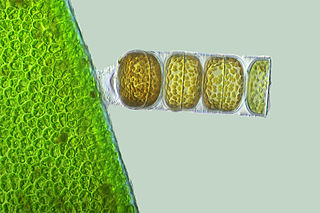
Lyngbya is a genus of cyanobacteria, unicellular autotrophs that form the basis of the oceanic food chain.

Oscillatoria is a genus of very important sugar making microscopic creatures

Moorea producens is a species of filamentous cyanobacteria in the genus Moorea, including tropical marine strains formerly classified as Lyngbya majuscula due to morphological resemblance but separated based on genetic evidence. Moorea producens grows on seagrass and is one of the causes of the human skin irritation seaweed dermatitis. It is known as fireweed in Australia and stinging limu in Hawaii.
Oocystaceae is a family of green algae, in the order Chlorellales. The type genus is Oocystis.

Scytonema is a genus of photosynthetic cyanobacteria that contains over 100 species. It grows in filaments that form dark mats. Many species are aquatic and are either free-floating or grow attached to a submerged substrate, while others species grow on terrestrial rocks, wood, soil, or plants. Scytonema is a nitrogen fixer, and can provide fixed nitrogen to the leaves of plants on which it is growing. Some species of Scytonema form a symbiotic relationship with fungi to produce a lichen.

Planktothrix is a diverse genus of filamentous cyanobacteria observed to amass in algal blooms in water ecosystems across the globe. Like all Oscillatoriales, Planktothrix species have no heterocysts and no akinetes. Planktothrix are unique because they have trichomes and contain gas vacuoles unlike typical planktonic organisms. Previously, some species of the taxon were grouped within the genus Oscillatoria, but recent work has defined Planktothrix as its own genus. A tremendous body of work on Planktothrix ecology and physiology has been done by Anthony E. Walsby, and the 55.6 kb microcystin synthetase gene which gives these organisms the ability to synthesize toxins has been sequenced. P. agardhii is an example of a type species of the genus. P. agardhii and P. rubescens are commonly observed in lakes of the Northern Hemisphere where they are known producers of potent hepatotoxins called microcystins.
Trichodesmium thiebautii is a cyanobacteria that is often found in open oceans of tropical and subtropical regions and is known to be a contributor to large oceanic surface blooms. This microbial species is a diazotroph, meaning it fixes nitrogen gas (N2), but it does so without the use of heterocysts. T. thiebautii is able to simultaneously perform oxygenic photosynthesis. T. thiebautii was discovered in 1892 by M.A. Gomont. T. thiebautii are important for nutrient cycling in marine habitats because of their ability to fix N2, a limiting nutrient in ocean ecosystems.

Oscillatoria brevis is a species of the genus Oscillatoria first identified in 1892. It is a blue-green filamentous cyanobacterium, which can be found in brackish and fresh waterways. O. brevis can also be isolated from soil.

Maurice-Augustin Gomont was a French phycologist.
Amorphonostoc is a genus of cyanobacteria belonging to the family Nostocaceae.

Fischerella is a genus of cyanobacteria belonging to the family Hapalosiphonaceae.
Kamptonema is a genus of cyanobacteria belonging to the family Microcoleaceae.
Kamptonema chlorinum is a species of cyanobacteria belonging to the family Microcoleaceae.
Jaaginema is a genus of cyanobacteria belonging to the family Pseudanabaenaceae.

Melosira is a genus of diatoms belonging to the family Melosiraceae.
Phormidium aerugineo-caeruleum is a species of cyanobacteria in the genus Phormidium.
Phormidium allorgei is a species of cyanobacteria in the genus Phormidium.
Phormidium ambiguum is a species of cyanobacteria in the genus Phormidium.
Phormidium africanum is a species of cyanobacterium in the genus Phormidium.
Spirulina major is a species of cyanobacteria in the family Spirulinaceae. It's found primarily in the Gulf of Mexico and sparsely on the shores of South America, Africa, Europe, the Middle East, and India.









